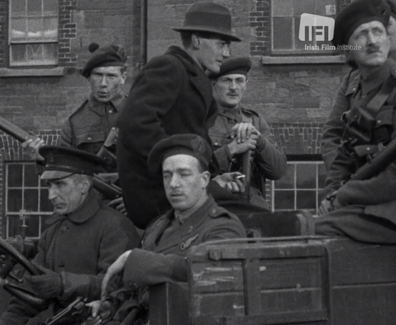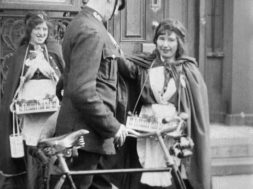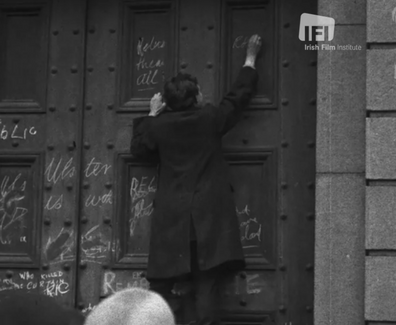Peace Council at the Palace
This is typical of the newsreels’ optimism that a peaceful solution could be found to the Irish question. In spite of the fact that this item reports the ‘splendid news’ that ‘peace was signed’ and depicts amicable interactions between the British and Irish delegation, the negotiations had been difficult and protracted. Michael Collins later reported his realization that he had just signed his own death warrant. Eight months later the newsreels would be reporting his funeral.
Go to the Read More section below for notes by Ciara Chambers.
Shots from this particular newsreel appear on a cinema screen in a sequence in Ken Loach’s The Wind that Shakes the Barley (2006). An audience watches a cinema newsreel depicting the signing of the Treaty. There are angry responses from viewers as the details of the Treaty are revealed. What we see on screen is not one newsreel but several, some released months apart, edited together in order to illustrate Irish responses in the wake of the peace agreement which led the country into Civil War. While Loach manipulates newsreel content he powerfully demonstrates how the newsreels presented a colonialist viewpoint to audiences who were watching reports on events which would have been at odds with their day to day experiences, never mind offensive to their political sensibilities. He constructs quite accurately some of the cinematic experience of the silent era that is well documented: the musical accompaniment, the vocal nature of the audience, the fact that intertitles were often read out by individuals for the benefit of those in the audience who were illiterate. However, due to the delayed nature of newsreel production in the early days of the industry, audiences were often watching pictures to match stories which they had knowledge about already through newspapers and word of mouth, so an audience learning about a momentous event like this through the newsreels would be highly unlikely. In the construction of his own newsreel, Loach reflects how early newsreel producers operated (using library footage or including shots of one location as a stand in for another) and he also demonstrates audience dissatisfaction with both the politics of the British newsreels’ consistently pro-establishment, colonialist perspective and the way in which Irish stories were represented. What is interesting about this scene is that it depicts some of what can be speculated about audience responses to the depiction of Irish events before and after partition. Loach’s decision to show an audience watching this newsreel in a cinema testifies to the power of the newsreel form and its ultimate failure to accurately represent the turbulent and complex nature of Irish politics.


